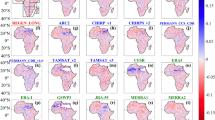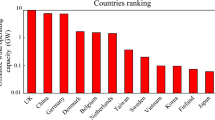Abstract
Rainfall and Reference Evapotranspiration (ETo) are the most fundamental and significant variables in hydrological modelling. However, these variables are generally not available over ungauged catchments. ETo estimation usually needs measurements of weather variables such as wind speed, air temperature, solar radiation and dew point. After the development of reanalysis global datasets such as the National Centre for Environmental Prediction (NCEP) and high performance modelling framework Weather Research and Forecasting (WRF) model, it is now possible to estimate the rainfall and ETo for any coordinates. In this study, the WRF modelling system was employed to downscale the global NCEP reanalysis datasets over the Brue catchment, England, U.K. After downscaling, two statistical bias correction schemes were used, the first was based on sophisticated computing algorithms i.e., Relevance Vector Machine (RVM), while the second was based on the more simple Generalized Linear Model (GLM). The statistical performance indices for bias correction such as %Bias, index of agreement (d), Root Mean Square Error (RMSE), and Correlation (r) indicated that the RVM model, on the whole, displayed a more accomplished bias correction of the variability of rainfall and ETo in comparison to the GLM. The study provides important information on the performance of WRF derived hydro-meteorological variables using NCEP global reanalysis datasets and statistical bias correction schemes which can be used in numerous hydro-meteorological applications.






Similar content being viewed by others
References
Abrahart R, See L (2007) Neural network modelling of non-linear hydrological relationships. Hydrol Earth Syst Sci 11:1563–1579
Allen RG, Pereira LS, Raes D, Smith M (1998) Crop evapotranspiration-guidelines for computing crop water requirements-FAO irrigation and drainage paper 56 FAO. Rome 300:6541
Borge R, Alexandrov V, José del Vas J, Lumbreras J, Rodríguez E (2008) A comprehensive sensitivity analysis of the WRF model for air quality applications over the Iberian Peninsula. Atmos Environ 42:8560–8574
Bringi V, Rico-Ramirez M, Thurai M (2011) Rainfall estimation with an operational polarimetric C-band radar in the United Kingdom: comparison with a gauge network and error analysis. J Hydrometeorol 12:935–954
Caldwell P, Chin H-NS, Bader DC, Bala G (2009) Evaluation of a WRF dynamical downscaling simulation over. Calif Clim Chang 95:499–521
Caputo B, Sim K, Furesjo F, Smola A (2002) Appearance-based Object Recognition using SVMs: Which Kernel Should I Use? In: Proc of NIPS workshop on Statistical methods for computational experiments in visual processing and computer vision, Whistler.
Chen F et al (2011) The integrated WRF/urban modelling system: development, evaluation, and applications to urban environmental problems. Int J Climatol 31:273–288
Chu PC, Fan C (1997) Sixth-order difference scheme for sigma coordinate ocean models. J Phys Oceanogr 27:2064–2071
Draxl C, Hahmann AN, Pena Diaz A, Nissen JN, Giebel G (2010) Validation of boundary-layer winds from WRF mesoscale forecasts with applications to wind energy forecasting. In: 19th Symposium on Boundary Layers and Turbulence
Dudhia J (1989) Numerical study of convection observed during the winter monsoon experiment using a mesoscale two-dimensional model. J Atmos Sci 46:3077–3107
Ghosh S, Mujumdar P (2008) Statistical downscaling of GCM simulations to streamflow using relevance vector machine. Adv Water Resour 31:132–146
Gilliland EK, Rowe CM (2007) A comparison of cumulus parameterization schemes in the WRF model. In: Proceedings of the 87th AMS Annual Meeting & 21th Conference on Hydrology. p 2.16
Grell GA, Dudhia J, Stauffer DR (1994) A description of the fifth-generation Penn State/NCAR mesoscale model (MM5), NCAR TECHNICAL NOTE, NCAR/TN-398 + STR, p128
Gutman G, Ignatov A (1998) The derivation of the green vegetation fraction from NOAA/AVHRR data for use in numerical weather prediction models. Int J Remote Sens 19:1533–1543
Hanna SR, Yang R (2001) Evaluations of mesoscale models’ simulations of near-surface winds, temperature gradients, and mixing depths. J Appl Meteorol 40:1095–1104
Heikkila U, Sandvik A, Sorteberg A (2011) Dynamical downscaling of ERA-40 in complex terrain using the WRF regional climate model. Clim Dyn 37:1551–1564. doi:10.1007/s00382-010-0928-6
Heikkilä U, Sandvik A, Sorteberg A (2011) Dynamical downscaling of ERA-40 in complex terrain using the WRF regional climate model. Clim Dyn 37:1551–1564
Hong Y, Hsu KL, Sorooshian S, Gao X (2004) Precipitation estimation from remotely sensed imagery using an artificial neural network cloud classification system. J Appl Meteorol 43:1834–1853
Hu XM, Nielsen-Gammon JW, Zhang F (2010) Evaluation of three planetary boundary layer schemes in the WRF model. J Appl Meteorol Climatol 49:1831–1844
Ishak A, Remesan R, Srivastava P, Islam T, Han D (2013) Error correction modelling of wind speed through hydro-meteorological parameters and mesoscale model: a hybrid approach. Water Resour Manag 27:1–23. doi:10.1007/s11269-012-0130-1
Ishak AM, Srivastava PK, Gupta M, Islam T (2014) The development of numerical weather models-a review. Bull Environ Sci Res 3:15–20
Islam T, Rico-Ramirez MA, Han D, Srivastava PK, Ishak AM (2012a) Performance evaluation of the TRMM precipitation estimation using ground-based radars from the GPM validation network. J Atmos Sol Terr Phys 77:194–208
Islam T, Rico-Ramirez MA, Han D, Srivastava PK (2012b) A Joss–Waldvogel disdrometer derived rainfall estimation study by collocated tipping bucket and rapid response rain gauges. Atmos Sci Lett 13:139–150
Islam T, Rico-Ramirez MA, Han D, Bray M, Srivastava PK (2013) Fuzzy logic based melting layer recognition from 3 GHz dual polarization radar: appraisal with NWP model and radio sounding observations. Theor Appl Climatol 112:317–338
Islam T, Srivastava PK, Gupta M, Zhu X, Mukherjee S (2014) Computational Intelligence Techniques in Earth and Environmental Sciences. Springer, Netherlands
Johnson RA, Wichern DW (2002) Applied multivariate statistical analysis, vol 4. Prentice hall Upper Saddle River, NJ
Legates DR, McCabe GJ Jr (1999) Evaluating the use of “goodness-of-fit” measures in hydrologic and hydroclimatic model validation. Water Resour Res 35:233–241
Liolios KA, Moutsopoulos KN, Tsihrintzis VA (2014) Comparative modeling of HSF constructed wetland performance with and without evapotranspiration and rainfall. Environ Process 1:171–186
Lo JCF, Yang ZL, Pielke RA (2008) Assessment of three dynamical climate downscaling methods using the Weather Research and Forecasting (WRF) model. J Geophys Res: Atmos (1984–2012) 113
Lorenc AC (1986) Analysis methods for numerical weather prediction. Q J R Meteorol Soc 112:1177–1194
Mahmood R, Hubbard KG (2005) Assessing bias in evapotranspiration and soil moisture estimates due to the use of modeled solar radiation and dew point temperature data. Agric For Meteorol 130:71–84
McCullagh P, Nelder JA (1989) Generalized linear models, Chapman and Hall/CRC press. ISBN-13: 978–0412317606, p 532
Mlawer EJ, Taubman SJ, Brown PD, Iacono MJ, Clough SA (1997) Radiative transfer for inhomogeneous atmospheres: RRTM, a validated correlated-k model for the longwave. J Geophys Res 102:16663–16616,16682
Monteith J (1965) Evaporation and environment. pp 205–234
Penman H (1956) Estimating evaporation. Trans Am Geophys Union 37:43–50
Petropoulos GP, Carlson TN, Griffiths H (eds) (2013) Turbulent Fluxes of Heat and Moisture at the Earth’s Land Surface: Importance, Controlling Parameters and Conventional Measurement, Chapter 1, pages 3–28, in “Remote Sensing of Energy Fluxes and Soil Moisture Content”, by G.P. Petropoulos, Taylor and Francis, ISBN: 978-1-4665-0578-0. CRC Press
Piani C, Haerter JO, Coppola E (2010a) Statistical bias correction for daily precipitation in regional climate models over. Eur Theor Appl Climatol 99:187–192. doi:10.1007/s00704-009-0134-9
Piani C, Weedon G, Best M, Gomes S, Viterbo P, Hagemann S, Haerter J (2010b) Statistical bias correction of global simulated daily precipitation and temperature for the application of hydrological models. J Hydrol 395:199–215
Price K, Purucker T, Andersen T, Knightes C, Cooter E, Otte T (2012) Comparison of Spatial and Temporal Rainfall Characteristics of WRF-Simulated Precipitation to gauge and radar observations. In: AGU Fall Meeting Abstracts. p 1295
Ritter B, Geleyn J-F (1992) A comprehensive radiation scheme for numerical weather prediction models with potential applications in climate simulations. Mon Weather Rev 120:303–325
Schoof JT, Pryor S (2001) Downscaling temperature and precipitation: a comparison of regression-based methods and artificial neural networks. Int J Climatol 21:773–790
Skamarock WC, Klemp JB, Dudhia J, Gill DO, Barker DM, Wang W, Powers JG (2005) A description of the advanced research WRF version 2, (No. NCAR/TN-468+ STR). National Center for Atmospheric Research Boulder Co Mesoscale and Microscale Meteorology Divison
Srivastava PK (2013) Soil Moisture Estimation from SMOS Satellite and Mesoscale Model for Hydrological Applications. PhD Thesis, University of Bristol, Bristol, United Kingdom
Srivastava PK, Han D, Ramirez MR, Islam T (2013a) Machine learning techniques for downscaling SMOS satellite soil moisture using MODIS land surface temperature for hydrological application. Water Resour Manag 27:3127–3144
Srivastava PK, Han D, Rico-Ramirez MA, Al-Shrafany D, Islam T (2013b) Data fusion techniques for improving soil moisture deficit using SMOS satellite and WRF-NOAH land surface model. Water Resour Manag 27:5069–5087
Srivastava PK, Han D, Rico-Ramirez MA, Islam T (2013c) Appraisal of SMOS soil moisture at a catchment scale in a temperate maritime climate. J Hydrol 498:292–304
Srivastava PK, Han D, Rico Ramirez MA, Islam T (2013d) Comparative assessment of evapotranspiration derived from NCEP and ECMWF global datasets through weather research and forecasting model. Atmos Sci Lett 14:118–125
Srivastava PK, Han D, Rico-Ramirez MA, Bray M, Islam T, Gupta M, Dai Q (2014a) Estimation of land surface temperature from atmospherically corrected LANDSAT TM image using 6S and NCEP global reanalysis product. Environ Earth Sci 72:5183–5196
Srivastava PK, Han D, Rico-Ramirez MA, Islam T (2014b) Sensitivity and uncertainty analysis of mesoscale model downscaled hydro-meteorological variables for discharge prediction. Hydrol Process 28:4419–4432. doi:10.1002/hyp.9946
Srivastava PK, Han D, Rico-Ramirez MA, O’Neill P, Islam T, Gupta M (2014c) Assessment of SMOS soil moisture retrieval parameters using tau–omega algorithms for soil moisture deficit estimation. J Hydrol 519:574–587
Srivastava PK, Mukherjee S, Gupta M, Islam T (2014d) Remote Sensing Applications in Environmental Research. Springer, Verlag
Taylor KE (2001) Summarizing multiple aspects of model performance in a single diagram. J Geophys Res: Atmos (1984–2012) 106:7183–7192
Tipping ME (2001) Sparse Bayesian learning and the relevance vector machine. J Mach Learn Res 1:211–244
Trigo RM, Palutikof JP (2001) Precipitation scenarios over Iberia: a comparison between direct GCM output and different downscaling techniques. J Clim 14:4422–4446
Vaidya S, Singh S (2000) Applying the Betts-Miller-Janjic scheme of convection in prediction of the Indian monsoon. Weather Forecast 15: 349–356
Weichert A, Bürger G (1998) Linear versus nonlinear techniques in downscaling. Clim Res 10:83–93
Willmott CJ et al (1985) Statistics for the evaluation and comparison of models. J Geophys Res 90:8995–9005
Zhong X (1996) Additive semi-implicit Runge–Kutta methods for computing high-speed nonequilibrium reactive flows. J Comput Phys 128: 19–31
Acknowledgments
The first authors would like to thank the Commonwealth Scholarship Commission, British Council, United Kingdom and Ministry of Human Resource Development, Government of India for providing the necessary support and funding for this research. The authors are also thankful to Research Data Archive (RDA) which is maintained by the Computational and Information Systems Laboratory (CISL) at the National Center for Atmospheric Research (NCAR). The authors would like to acknowledge the British Atmospheric Data Centre, United Kingdom for providing the ground observation datasets. The authors also acknowledge the Advanced Computing Research Centre at University of Bristol for providing the access to supercomputer facility (The Blue Crystal). Dr. Petropoulos’s contribution was supported by the European Commission Marie Curie Re-Integration Grant “TRANSFORM-EO” and the High Performance Computing Facilities of Wales “PREMIER-EO” projects. Authors would also like to thank Gareth Ireland for the language proof reading of the manuscript. Authors are also grateful to the anonymous reviewers for their useful criticism which helped improving the manuscript. The views expressed here are those of the authors solely and do not constitute a statement of policy, decision, or position on behalf of NOAA/NASA or the authors’ affiliated institutions.
Author information
Authors and Affiliations
Corresponding author
Rights and permissions
About this article
Cite this article
Srivastava, P.K., Islam, T., Gupta, M. et al. WRF Dynamical Downscaling and Bias Correction Schemes for NCEP Estimated Hydro-Meteorological Variables. Water Resour Manage 29, 2267–2284 (2015). https://doi.org/10.1007/s11269-015-0940-z
Received:
Accepted:
Published:
Issue Date:
DOI: https://doi.org/10.1007/s11269-015-0940-z




